Effectiveness Analysis of Systematic Combined Sewer Overflow Control Schemes in the Sponge City Pilot Area of Beijing
Abstract
:1. Introduction
2. Materials and Methods
2.1. Study Area Description
2.2. Data Collection
2.3. Model Set Up and Evaluation Criteria
3. Design of CSO Pollution Control Schemes
3.1. CSO Pollution Control Target
3.2. Design of Control Schemes
4. Results and Discussion
4.1. Model Calibration and Validation
4.2. Simulation Results of Current CSO Conditions
4.3. Simulation Results of Control Schemes without Storage Tanks
4.4. Regularity Analysis
4.4.1. Effect of LID and Pipe Retrofitting
4.4.2. Relationship Among Storage Tank Volume, CSO Frequency, and CSO Volume
5. Conclusions
Author Contributions
Funding
Conflicts of Interest
References
- Barco, J.; Papiri, S.; Stenstrom, M.K. First flush in a combined sewer system. Chemosphere 2008, 71, 827–833. [Google Scholar] [CrossRef] [PubMed]
- Even, S.; Mouchel, J.M.; Servais, P.; Flipo, N.; Poulin, M.; Blanc, S.; Chabanel, M.; Paffoni, C. Modelling the impacts of Combined Sewer Overflows on the river Seine water quality. Sci. Total Environ. 2007, 375, 140–151. [Google Scholar] [CrossRef] [PubMed]
- US Environmental Protection Agency. Report to congress: Impacts and control of CSOs and SSOs. Available online: https://nepis.epa.gov/Exe/ZyNET.exe/30006O5F.txt?ZyActionD=ZyDocument&Client=EPA&Index=2000%20Thru%202005&Docs=&Query=&Time=&EndTime=&SearchMethod=1&TocRestrict=n&Toc=&TocEntry=&QField=&QFieldYear=&QFieldMonth=&QFieldDay=&UseQField=&IntQFieldOp=0&ExtQFieldOp=0&XmlQuery=&File=D%3A%5CZYFILES%5CINDEX%20DATA%5C00THRU05%5CTXT%5C00000008%5C30006O5F.txt&User=ANONYMOUS&Password=anonymous&SortMethod=h%7C-&MaximumDocuments=1&FuzzyDegree=0&ImageQuality=r75g8/r75g8/x150y150g16/i425&Display=hpfr&DefSeekPage=x&SearchBack=ZyActionL&Back=ZyActionS&BackDesc=Results%20page&MaximumPages=1&ZyEntry=1&slide (accessed on 26 April 2019).
- Fu, G.T.; Soonthiam, K.; Butler, D. Optimal distribution and control of storage tank to mitigate the impact of new developments on receiving water quality. J. Environ. Eng. 2010, 136, 335–342. [Google Scholar] [CrossRef]
- Gromaire, M.C.; Garnaud, S.; Saad, M.; Chebbo, G. Contribution of different sources to the pollution of wet weather flows in combined sewers. Water Res. 2001, 35, 521–533. [Google Scholar] [CrossRef]
- Soonthornnonda, P.; Christensen, E.R. Source apportionment of pollutants and flows of combined sewer wastewater. Water Res. 2008, 42, 1989–1998. [Google Scholar] [CrossRef] [PubMed]
- Mcpherson, T.N.; Burian, S.J.; Turin, H.J.; Stenstrom, M.K.; Suffet, I.H. Comparison of the pollutant loads in dry and wet weather runoff in a southern California urban watershed. Water Sci. Technol. 2002, 4, 255–261. [Google Scholar] [CrossRef]
- US Environmental Protection Agency. Combined Sewer Overflows: Guidance for Long-Term Control Plan. Available online: https://www.google.com/url?sa=t&rct=j&q=&esrc=s&source=web&cd=3&ved=2ahUKEwin8qjq4uzhAhXOZt4KHdbWAh4QFjACegQIAhAC&url=https%3A%2F%2Fwww3.epa.gov%2Fnpdes%2Fpubs%2Fowm0272.pdf&usg=AOvVaw02bZblYL04quFYuVwXQTtc (accessed on 26 April 2019).
- Bratieres, K.; Fletcher, T.D.; Deletic, A.; Zinger, Y. Nutrient and sediment removal by stormwater biofilters: A large-scale design optimisation study. Water Res. 2008, 42, 3930–3940. [Google Scholar] [CrossRef] [PubMed]
- Davis, A.P.; Shokouhian, M.; Ni, S. Loading estimates of lead, copper, cadmium, and zinc in urban runoff from specific sources. Chemosphere 2001, 44, 997–1009. [Google Scholar] [CrossRef]
- Marengo, B.; Cahill, T.; Wible, D.; Marm, C.; Johnstone, R. Developing Green Streets Prototypes to Reduce Combined Sewer Overflows for Cincinnati, Ohio. In Proceedings of the World Environmental and Water Resources Congress 2009, Kansas City, MO, USA, 17–21 May 2009. [Google Scholar]
- Montalto, F.; Behr, C.; Alfredo, K.; Wolf, M.; Arye, M.; Walsh, M. Rapid assessment of the cost-effectiveness of low impact development for CSO control. Landscape Urban Plann. 2007, 82, 117–131. [Google Scholar] [CrossRef]
- Wang, J.; Guo, Y. An analytical stochastic approach for evaluating the performance of combined sewer overflow tanks. Water Resour. Res. 2018, 54, 3357–3375. [Google Scholar] [CrossRef]
- Phillips, J.; Buchanan, P. Green Stormwater Infrastructure Use to Control Combined Sewer Overflows. In Proceedings of the Pipelines Conference 2011, Seattle, WA, USA, 23–27 July 2011; pp. 1463–1476. [Google Scholar]
- U.S. Environmental Protection Agency; Bingham, D.; Golden, J.; Walker, D.; Driscoll, E. Manual: Combined Sewer Overflow Control. Available online: https://cfpub.epa.gov/si/si_public_record_Report.cfm?Lab=ORD&dirEntryID=44055 (accessed on 26 April 2019).
- Port Angeles, W. Combined Sewer Overflows (CSO) Frequency Asked Questions. Available online: http://www.cityofpa.us/DocumentCenter/View/261 (accessed on 15 January 2019).
- Alves, A.; Sanchez, A.; Vojinovic, Z.; Seyoum, S.; Babel, M.; Brdjanovic, D. Evolutionary and holistic assessment of green-grey infrastructure for CSO reduction. Water 2016, 8, 402. [Google Scholar] [CrossRef]
- Patwardhan, A.S.; Hare, J.T.; Jobes, T.; Medina, D. Analyzing potential benefits of low impact development in reducing combined sewers overflows. In Proceedings of the World Water and Environmental Resources Congress 2005, Anchorage, AK, USA, 15–19 May 2005. [Google Scholar]
- Neilson, I.; Turney, D. Green Infrastructure Optimization Analyses for Combined Sewer Overflow (CSO) Control. In Proceedings of the Low Impact Development 2010: Redefining Water in the City, San Francisco, CA, USA, 11–14 April 2010; pp. 1533–1541. [Google Scholar]
- Tavakol-Davani, H. Watershed-scale life cycle assessment of rainwater harvesting systems to control combined sewer overflows. Ph.D. Thesis, University of Utah, Salt Lake City, UT, USA, 8 March 2016. [Google Scholar]
- Cohen, J.P.; Field, R.; Tafuri, A.N.; Ports, M.A. Cost comparison of conventional gray combined sewer overflow control infrastructure versus a green/gray combination. J. Irrig. Drain. Eng. 2011, 138, 534–540. [Google Scholar] [CrossRef]
- Sansalone, J.J.; Kuang, X.; Ranieri, V. Porous Pavement as a Hydraulic and Filtration Interface for Urban Drainage. J. Irrig. Drain. Eng. 2008, 134, 666–674. [Google Scholar] [CrossRef]
- Liu, J.; Davis, A.P. Phosphorus speciation and treatment using enhanced phosphorus removal bioretention. Environ. Sci. Technol. 2013, 48, 607–614. [Google Scholar] [CrossRef] [PubMed]
- Econsult Solutions, Inc. The Economic Impact of Green City, Clean Waters: The First Five Years. Available online: https://econsultsolutions.com/the-economic-impact-of-green-city-clean-waters-the-first-five-years/ (accessed on 26 April 2019).
- Moriasi, D.N.; Arnold, J.G.; Van Liew, M.W.; Bingner, R.L.; Harmel, R.D.; Veith, T.L. Model evaluation guidelines for systematic quantification of accuracy in watershed simulations. Trans. ASABE 2007, 50, 885–900. [Google Scholar] [CrossRef]
- Eaton, T.T. Approach and Case-Study of Green Infrastructure Screening Analysis for Urban Stormwater Control. Available online: https://www.google.com/url?sa=t&rct=j&q=&esrc=s&source=web&cd=1&ved=2ahUKEwjV97eH6ezhAhUQO3AKHUhADpUQFjAAegQIABAB&url=http%3A%2F%2Fgsipartners.sbnphiladelphia.org%2Fwp-content%2Fuploads%2F2016%2F02%2FSBN_FINAL-REPORT.pdf&usg=AOvVaw0NKb40MDbuqBU6fehC1aDX (accessed on 26 April 2019).
- Tavakol-Davani, H.; Burian, S.J.; Devkota, J.; Apul, D. Performance and cost-based comparison of green and gray infrastructure to control combined sewer overflows. J. Sustain. Water Built Environ. 2015, 2, 04015009. [Google Scholar] [CrossRef]
- Sebti, A.; Fuamba, M.; Bennis, S. Optimization model for BMP selection and placement in a combined sewer. J. Water Resour. Plan. Manag. 2015, 142, 04015068. [Google Scholar] [CrossRef]
- John, M.; Mastracchio, M.F.M. Stormwater In-Lieu Fee and Credit Banking and Trading Feasibility Report. 31 March 2017. Available online: https://www.google.com/url?sa=t&rct=j&q=&esrc=s&source=web&cd=1&ved=2ahUKEwjV97eH6ezhAhUQO3AKHUhADpUQFjAAegQIABAB&url=http%3A%2F%2Fgsipartners.sbnphiladelphia.org%2Fwp-content%2Fuploads%2F2016%2F02%2FSBN_FINAL-REPORT.pdf&usg=AOvVaw0NKb40MDbuqBU6fehC1aDX (accessed on 26 April 2019).
- Sousa, M.H.D.; Montalto, F.A.; Spatari, S. Using Life Cycle Assessment to Evaluate Green and Grey Combined Sewer Overflow Control Strategies. J. Ind. Ecol. 2012, 16, 901–913. [Google Scholar] [CrossRef]
- Tao, J.; Li, Z.; Peng, X.; Ying, G. Quantitative analysis of impact of green stormwater infrastructures on combined sewer overflow control and urban flooding control. Front. Environ. Sci. Eng. Chin. 2017, 11, 93–104. [Google Scholar] [CrossRef]
- Kubiak, D.A. Combined Sewer Overflow Control Plan: Annual Progress Report 2010. Massachusetts Water Resources Authority 2011. Available online: https://www.google.com/url?sa=t&rct=j&q=&esrc=s&source=web&cd=1&ved=2ahUKEwjV97eH6ezhAhUQO3AKHUhADpUQFjAAegQIABAB&url=http%3A%2F%2Fgsipartners.sbnphiladelphia.org%2Fwp-content%2Fuploads%2F2016%2F02%2FSBN_FINAL-REPORT.pdf&usg=AOvVaw0NKb40MDbuqBU6fehC1aDX (accessed on 26 April 2018).
- Blackmon, M.; Hison, R.; Cannon, R.J.; Cavanagh, P.; Driskell, G.; Sedlak, M.; Roberts, W.T.; Tait, P.E. Investment in Reducing Combined Sewer Oerflows Pays Dividends. Available online: https://www.google.com/url?sa=t&rct=j&q=&esrc=s&source=web&cd=1&ved=2ahUKEwjV97eH6ezhAhUQO3AKHUhADpUQFjAAegQIABAB&url=http%3A%2F%2Fgsipartners.sbnphiladelphia.org%2Fwp-content%2Fuploads%2F2016%2F02%2FSBN_FINAL-REPORT.pdf&usg=AOvVaw0NKb40MDbuqBU6fehC1aDX (accessed on 26 April 2019).
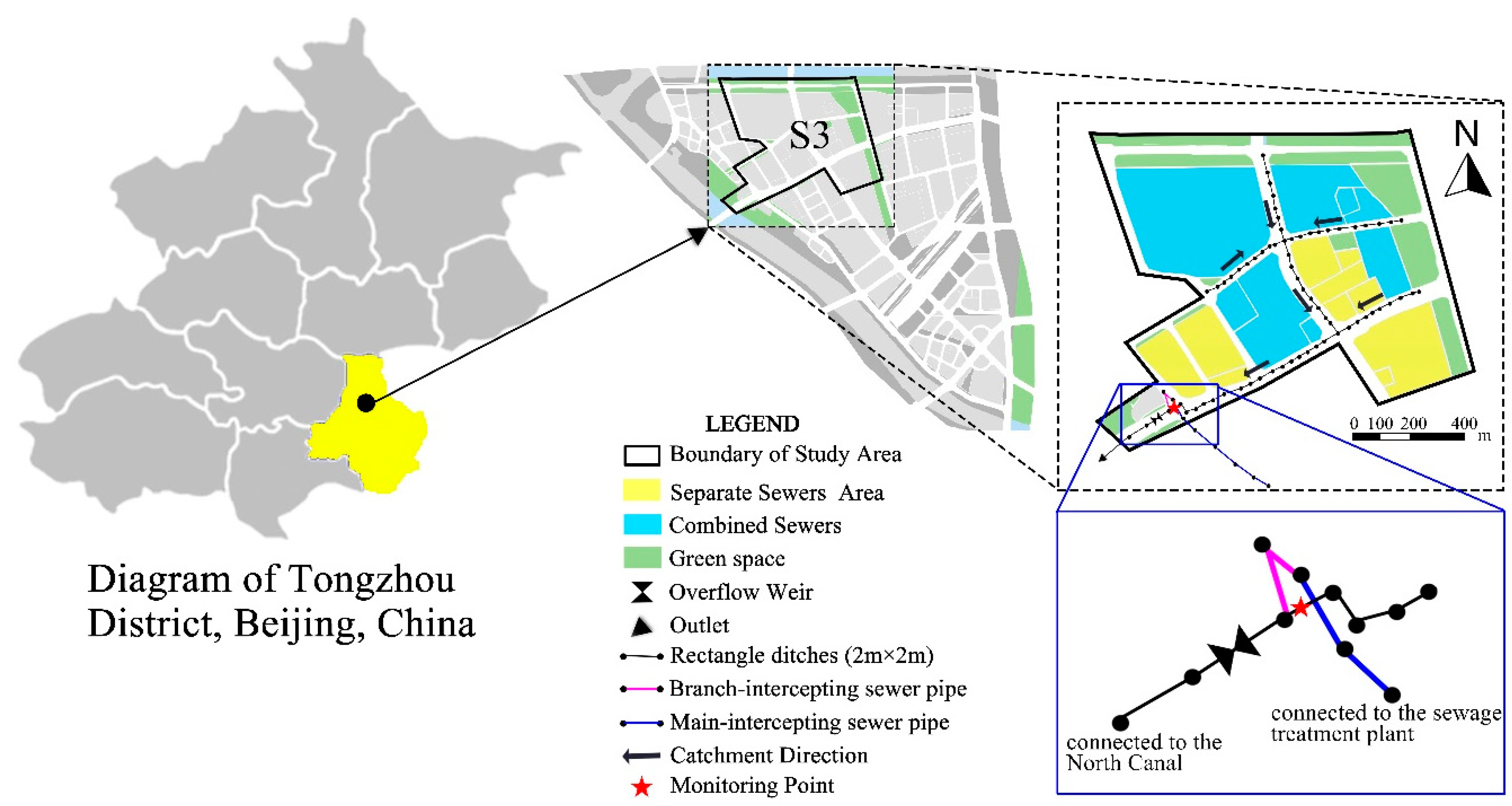
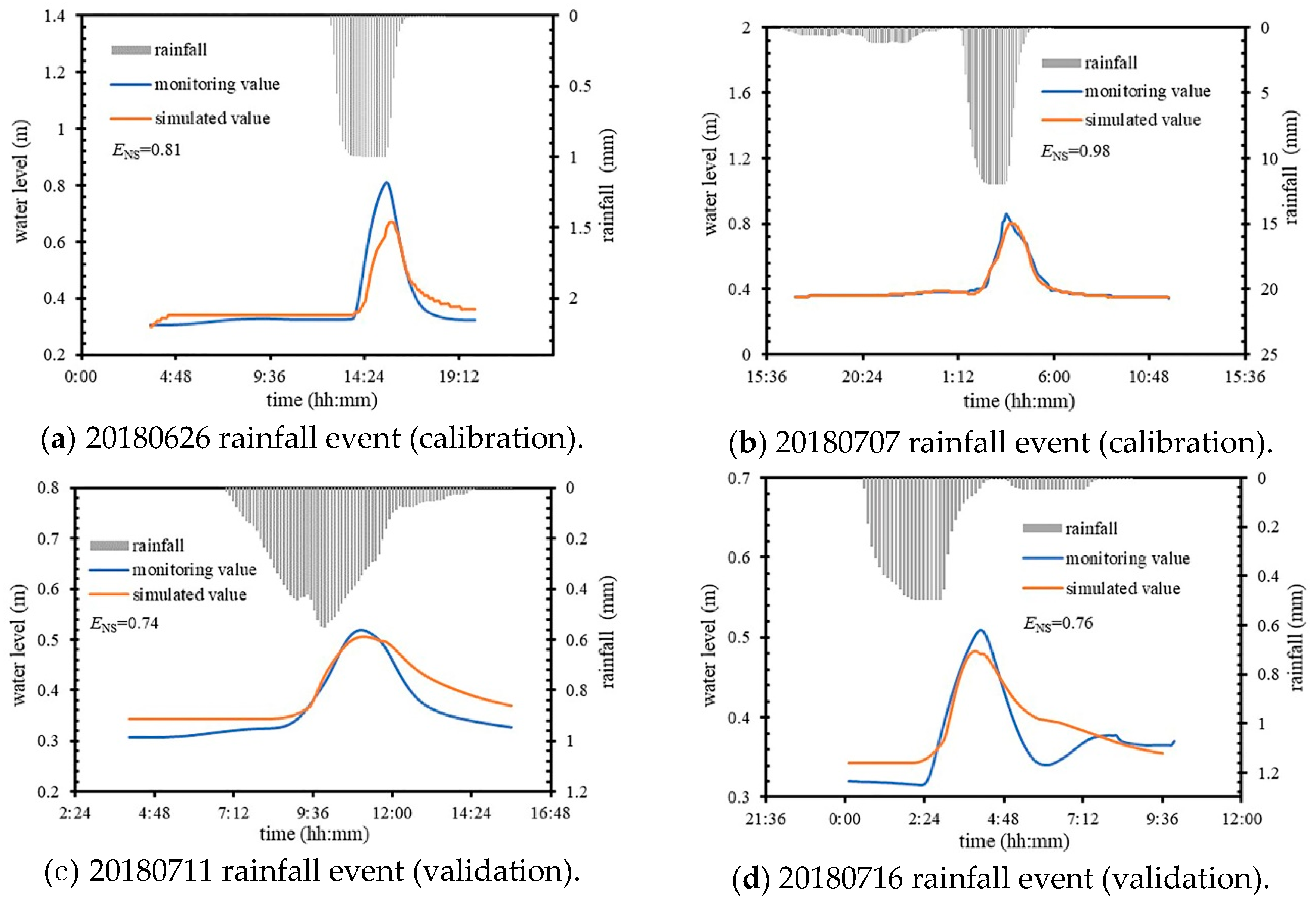
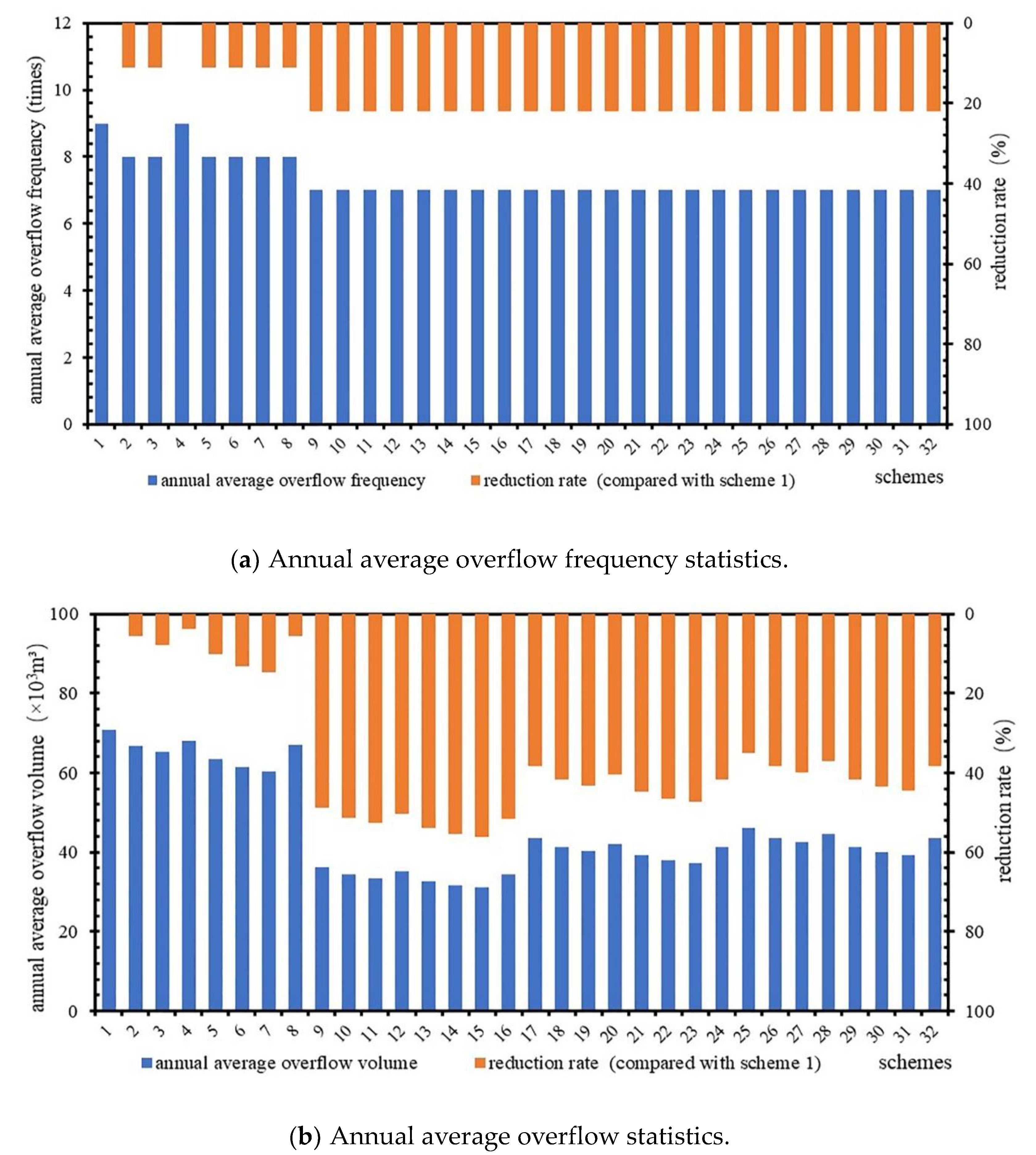
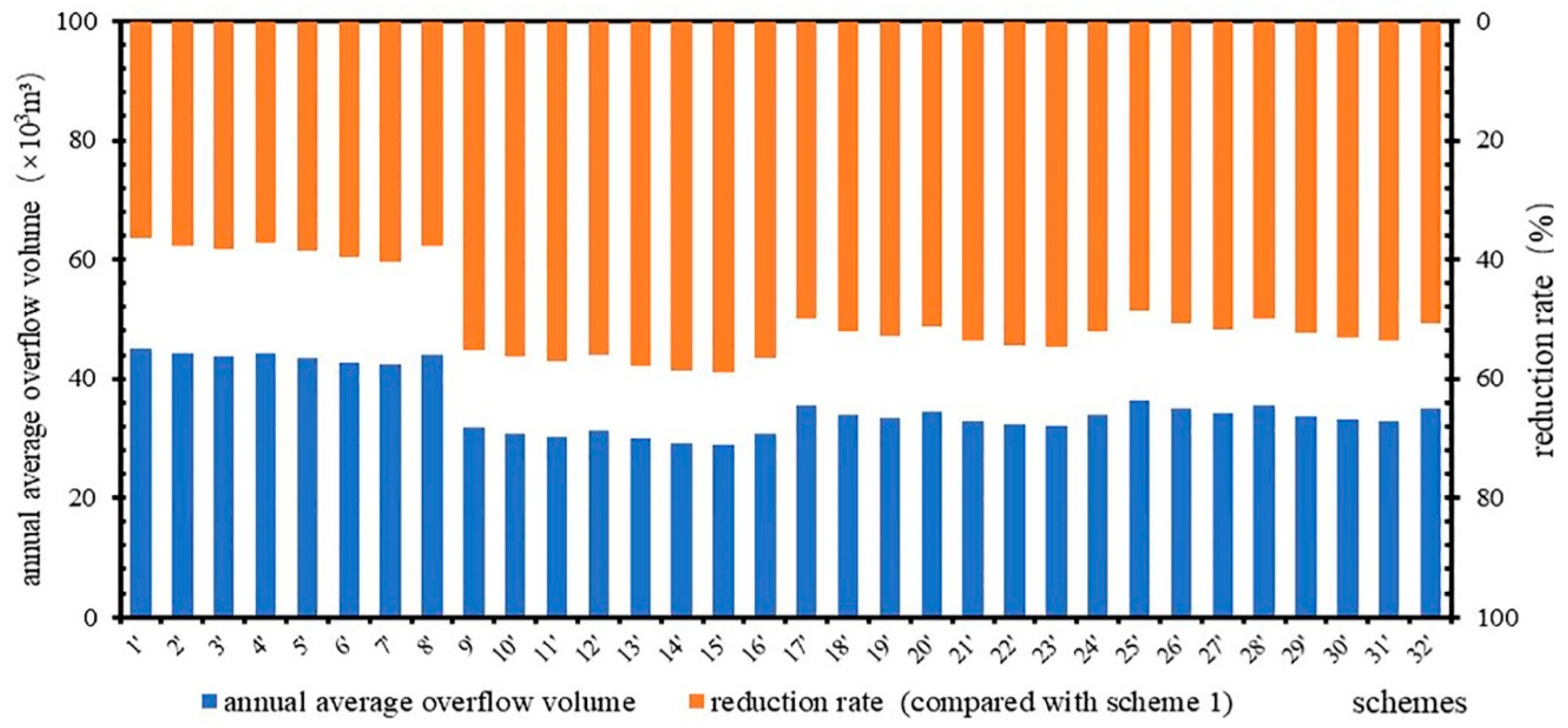
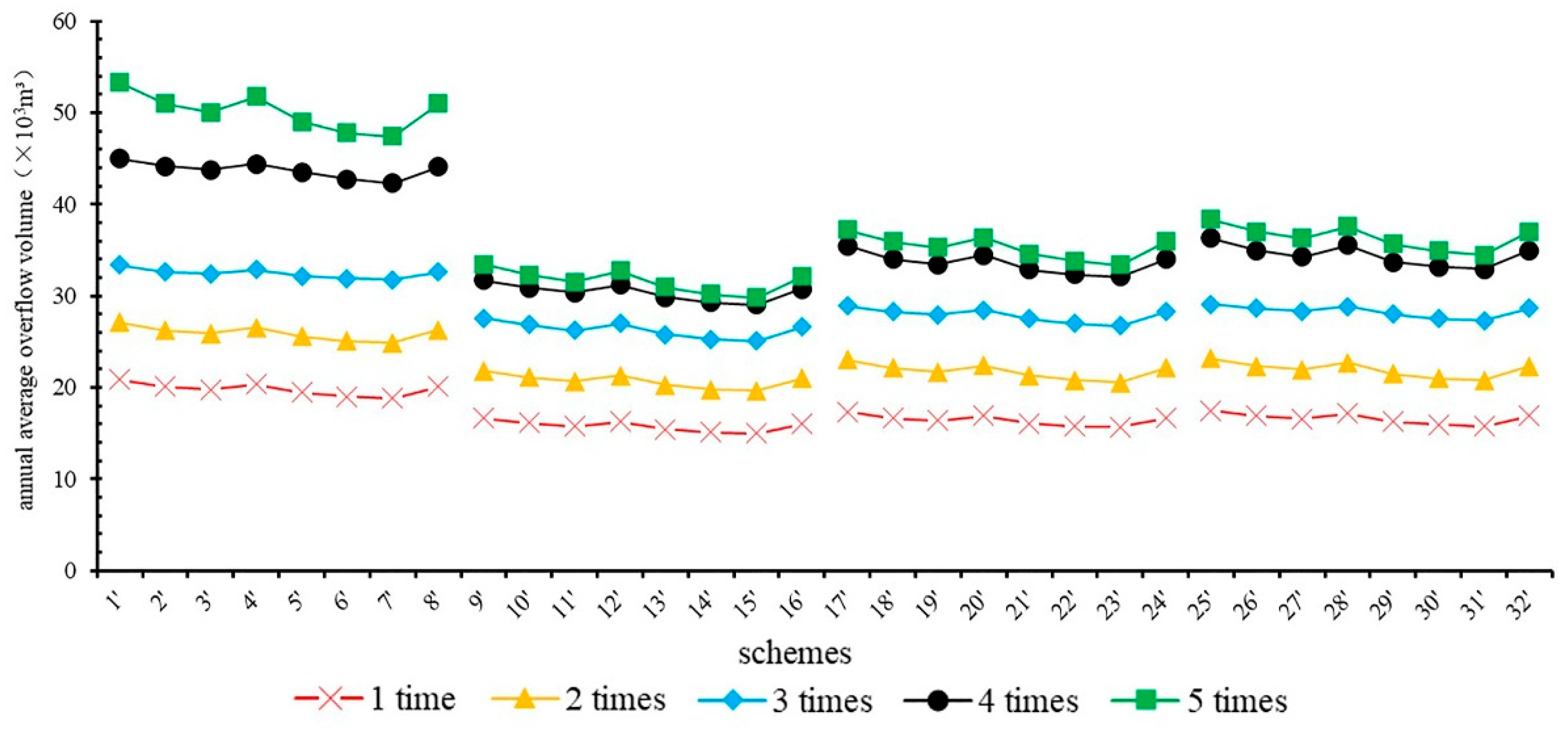
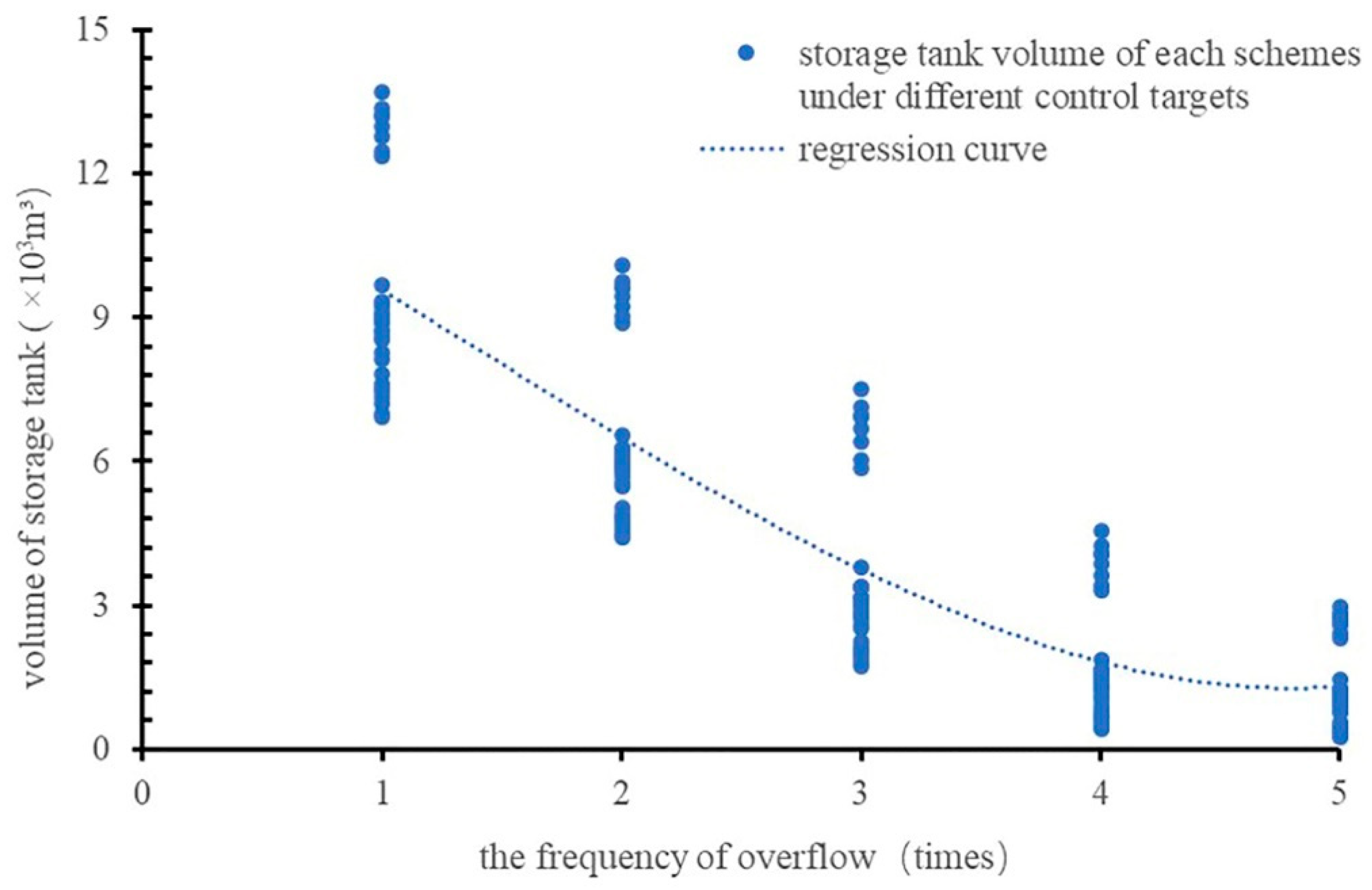
| Date of Rainfall Event | Rainfall Depth (mm) | Duration (h) | Maximum Intensity (mm/min) | Maximum Water Level (m) |
|---|---|---|---|---|
| 20180626 | 20 | 3.5 | 0.20 | 0.81 |
| 20180707 | 26 | 16.9 | 0.20 | 0.85 |
| 20180711 | 30 | 23.8 | 0.11 | 0.52 |
| 20180716 | 11 | 3.5 | 0.10 | 0.51 |
| Design Strategy | Sequence Number | Design Basis |
|---|---|---|
| strategy based on the goal | ① | Set the control target according to the “Code for design of stormwater management and harvest engineering (DB11/685—2013)” |
| ② | Set the control target according to the target of 75% volume capture ratio of annual rainfall set by Tongzhou Sponge City | |
| strategy based on the actual survey | ③ | Set the control target according to actual situation |
| Branch-Intercepting Pipe Diameter (mm) | 500 | 600 | 700 | 800 | |
|---|---|---|---|---|---|
| Main-Intercepting Pipe Diameter (mm) | |||||
| 800 | 5-8 | 6-8 | 7-8 | - | |
| 900 | 5-9 | 6-9 | 7-9 | 8-9 | |
| 1000 | 5-10 | - | - | - | |
| Type | Scheme | Source Control Strategy | Mid-way Control Strategy |
|---|---|---|---|
| Type I | 1 | -- | 5–8 |
| 2 | -- | 6–8 | |
| 3 | -- | 7–8 | |
| 4 | -- | 5–9 | |
| 5 | -- | 6–9 | |
| 6 | -- | 7–9 | |
| 7 | -- | 8–9 | |
| 8 | -- | 5–10 | |
| Type II | 9 | ① | 5–8 |
| 10 | ① | 6–8 | |
| 11 | ① | 7–8 | |
| 12 | ① | 5–9 | |
| 13 | ① | 6–9 | |
| 14 | ① | 7–9 | |
| 15 | ① | 8–9 | |
| 16 | ① | 5–10 | |
| Type III | 17 | ② | 5–8 |
| 18 | ② | 6–8 | |
| 19 | ② | 7–8 | |
| 20 | ② | 5–9 | |
| 21 | ② | 6–9 | |
| 22 | ② | 7–9 | |
| 23 | ② | 8–9 | |
| 24 | ② | 5–10 | |
| Type IV | 25 | ③ | 5–8 |
| 26 | ③ | 6–8 | |
| 27 | ③ | 7–8 | |
| 28 | ③ | 5–9 | |
| 29 | ③ | 6–9 | |
| 30 | ③ | 7–9 | |
| 31 | ③ | 8–9 | |
| 32 | ③ | 5–10 |
| Type I | Type II | Type III | Type IV | ||||
|---|---|---|---|---|---|---|---|
| Scheme | Storage tank capacity (m3) | Scheme | Storage tank capacity (m3) | Scheme | Storage tank capacity (m3) | Scheme | Storage tank capacity (m3) |
| 1’ | 4600 | 9’ | 950 | 17’ | 1600 | 25’ | 1900 |
| 2’ | 4100 | 10’ | 750 | 18’ | 1450 | 26’ | 1700 |
| 3’ | 3900 | 11’ | 650 | 19’ | 1350 | 27’ | 1600 |
| 4’ | 4250 | 12’ | 800 | 20’ | 1500 | 28’ | 1750 |
| 5’ | 3650 | 13’ | 600 | 21’ | 1250 | 29’ | 1500 |
| 6’ | 3450 | 14’ | 500 | 22’ | 1100 | 30’ | 1350 |
| 7’ | 3350 | 15’ | 450 | 23’ | 1050 | 31’ | 1250 |
| 8’ | 4100 | 16’ | 750 | 24’ | 1450 | 32’ | 1700 |
© 2019 by the authors. Licensee MDPI, Basel, Switzerland. This article is an open access article distributed under the terms and conditions of the Creative Commons Attribution (CC BY) license (http://creativecommons.org/licenses/by/4.0/).
Share and Cite
Gong, Y.; Chen, Y.; Yu, L.; Li, J.; Pan, X.; Shen, Z.; Xu, X.; Qiu, Q. Effectiveness Analysis of Systematic Combined Sewer Overflow Control Schemes in the Sponge City Pilot Area of Beijing. Int. J. Environ. Res. Public Health 2019, 16, 1503. https://doi.org/10.3390/ijerph16091503
Gong Y, Chen Y, Yu L, Li J, Pan X, Shen Z, Xu X, Qiu Q. Effectiveness Analysis of Systematic Combined Sewer Overflow Control Schemes in the Sponge City Pilot Area of Beijing. International Journal of Environmental Research and Public Health. 2019; 16(9):1503. https://doi.org/10.3390/ijerph16091503
Chicago/Turabian StyleGong, Yongwei, Ye Chen, Lei Yu, Junqi Li, Xingyao Pan, Zhenyao Shen, Xiang Xu, and Qianying Qiu. 2019. "Effectiveness Analysis of Systematic Combined Sewer Overflow Control Schemes in the Sponge City Pilot Area of Beijing" International Journal of Environmental Research and Public Health 16, no. 9: 1503. https://doi.org/10.3390/ijerph16091503
APA StyleGong, Y., Chen, Y., Yu, L., Li, J., Pan, X., Shen, Z., Xu, X., & Qiu, Q. (2019). Effectiveness Analysis of Systematic Combined Sewer Overflow Control Schemes in the Sponge City Pilot Area of Beijing. International Journal of Environmental Research and Public Health, 16(9), 1503. https://doi.org/10.3390/ijerph16091503







